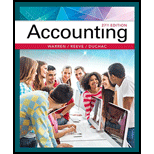
Accounting
27th Edition
ISBN: 9781337272094
Author: WARREN, Carl S., Reeve, James M., Duchac, Jonathan E.
Publisher: Cengage Learning,
expand_more
expand_more
format_list_bulleted
Concept explainers
Question
Chapter 26, Problem 26.5APE
(a)
To determine
Net present value method is the method which is used to compare the initial
To determine: The net present value of the Project A.
(b)
To determine
The project that provides the greatest net present value.
Expert Solution & Answer
Trending nowThis is a popular solution!

Students have asked these similar questions
General accounting question
Horizon Industries uses a job-order costing system and last period incurred
$77,000 of actual overhead and $95,000 of direct labor. The company estimates
that its overhead for the next period will be $80,000. It also expects to incur
$95,000 of direct labor.
What should be the predetermined overhead rate for the next period if
overhead is applied based on direct labor cost?
What is the PE ratio for fostertech inc. on these financial accounting question?
Chapter 26 Solutions
Accounting
Ch. 26 - What are the principal objections to the use of...Ch. 26 - Discuss the principal limitations of the cash...Ch. 26 - Prob. 3DQCh. 26 - Your boss has suggested that a one-year payback...Ch. 26 - Prob. 5DQCh. 26 - Prob. 6DQCh. 26 - A net present value analysis used to evaluate a...Ch. 26 - Two projects haw an identical net present value of...Ch. 26 - Prob. 9DQCh. 26 - What are the major disadvantages of the use of the...
Ch. 26 - Prob. 11DQCh. 26 - Give an example of a qualitative factor that...Ch. 26 - Prob. 13DQCh. 26 - Average rate of return Determine the average rate...Ch. 26 - Average rate of return Determine the average rate...Ch. 26 - Cash payback period A project has estimated annual...Ch. 26 - Cash payback period A project has estimated annual...Ch. 26 - Prob. 26.3APECh. 26 - Net present value A project has estimated annual...Ch. 26 - Internal rate of return A project is estimated to...Ch. 26 - Internal rate of return A project is estimated to...Ch. 26 - Prob. 26.5APECh. 26 - Prob. 26.5BPECh. 26 - Prob. 26.1EXCh. 26 - Average rate of returncost savings Midwest...Ch. 26 - Average rate of returnnew product Micro Tek Inc....Ch. 26 - Calculate cash flows Natures Way Inc. is planning...Ch. 26 - Cash payback period for a service company Prime...Ch. 26 - Cash payback method Lily Products Company is...Ch. 26 - Prob. 26.7EXCh. 26 - Prob. 26.8EXCh. 26 - Net present value methodannuity for a service...Ch. 26 - Prob. 26.10EXCh. 26 - Prob. 26.11EXCh. 26 - Prob. 26.12EXCh. 26 - Net present value method and present value index...Ch. 26 - Prob. 26.14EXCh. 26 - Cash payback period, net present value analysis,...Ch. 26 - Internal rate of return method The internal rate...Ch. 26 - Internal rate of return method for a service...Ch. 26 - Internal rate of return methodtwo projects Munch N...Ch. 26 - Prob. 26.19EXCh. 26 - Prob. 26.20EXCh. 26 - Prob. 26.21EXCh. 26 - Prob. 26.22EXCh. 26 - Sustainable energy capital investment analysis...Ch. 26 - Sustainable product capital investment analysis...Ch. 26 - Average rate of return method, net present value...Ch. 26 - Cash payback period, net present value method, and...Ch. 26 - Net present value method, present value index, and...Ch. 26 - Prob. 26.4APRCh. 26 - Alternative capital investments The investment...Ch. 26 - Capital rationing decision for a service company...Ch. 26 - Average rate of return method, net present value...Ch. 26 - Prob. 26.2BPRCh. 26 - Prob. 26.3BPRCh. 26 - Net present value method, internal rate of return...Ch. 26 - Prob. 26.5BPRCh. 26 - Capital rationing decision for a service company...Ch. 26 - Ethics in Action Danielle Hastings was recently...Ch. 26 - Communication Global Electronics Inc. invested...Ch. 26 - Prob. 26.4CPCh. 26 - Qualitative issues in investment analysis The...Ch. 26 - Prob. 26.6CP
Knowledge Booster
Learn more about
Need a deep-dive on the concept behind this application? Look no further. Learn more about this topic, accounting and related others by exploring similar questions and additional content below.Similar questions
- provide correct answer of this General accounting questionarrow_forwardDon't use ai given answer accounting questionsarrow_forwardConversion cost per unit equals $6. Total materials costs equal $60,000. Equivalent units for materials are 12,000. How much is the total manufacturing cost per unit? A. $15 B. $11 C. $13 D. $14arrow_forward
- Question 2.5.7: Job costing Tarikha Company has the following data: direct labor $232,000, direct materials used $182,000, total manufacturing overhead $240,000, and beginning work in process $32,000. Compute total manufacturing costs.arrow_forwardAssess the role of modern accounting theories in guiding research in accounting. Discuss how contemporary theories, such as stakeholder theory, legitimacy theory, and behavioral accounting theory, shape research questions, hypotheses formulation, and empirical analysisarrow_forwardchoose best answerarrow_forward
arrow_back_ios
SEE MORE QUESTIONS
arrow_forward_ios
Recommended textbooks for you
 Managerial AccountingAccountingISBN:9781337912020Author:Carl Warren, Ph.d. Cma William B. TaylerPublisher:South-Western College Pub
Managerial AccountingAccountingISBN:9781337912020Author:Carl Warren, Ph.d. Cma William B. TaylerPublisher:South-Western College Pub Financial And Managerial AccountingAccountingISBN:9781337902663Author:WARREN, Carl S.Publisher:Cengage Learning,
Financial And Managerial AccountingAccountingISBN:9781337902663Author:WARREN, Carl S.Publisher:Cengage Learning, EBK CONTEMPORARY FINANCIAL MANAGEMENTFinanceISBN:9781337514835Author:MOYERPublisher:CENGAGE LEARNING - CONSIGNMENT
EBK CONTEMPORARY FINANCIAL MANAGEMENTFinanceISBN:9781337514835Author:MOYERPublisher:CENGAGE LEARNING - CONSIGNMENT Cornerstones of Cost Management (Cornerstones Ser...AccountingISBN:9781305970663Author:Don R. Hansen, Maryanne M. MowenPublisher:Cengage LearningPrinciples of Accounting Volume 2AccountingISBN:9781947172609Author:OpenStaxPublisher:OpenStax College
Cornerstones of Cost Management (Cornerstones Ser...AccountingISBN:9781305970663Author:Don R. Hansen, Maryanne M. MowenPublisher:Cengage LearningPrinciples of Accounting Volume 2AccountingISBN:9781947172609Author:OpenStaxPublisher:OpenStax College Intermediate Financial Management (MindTap Course...FinanceISBN:9781337395083Author:Eugene F. Brigham, Phillip R. DavesPublisher:Cengage Learning
Intermediate Financial Management (MindTap Course...FinanceISBN:9781337395083Author:Eugene F. Brigham, Phillip R. DavesPublisher:Cengage Learning

Managerial Accounting
Accounting
ISBN:9781337912020
Author:Carl Warren, Ph.d. Cma William B. Tayler
Publisher:South-Western College Pub

Financial And Managerial Accounting
Accounting
ISBN:9781337902663
Author:WARREN, Carl S.
Publisher:Cengage Learning,

EBK CONTEMPORARY FINANCIAL MANAGEMENT
Finance
ISBN:9781337514835
Author:MOYER
Publisher:CENGAGE LEARNING - CONSIGNMENT

Cornerstones of Cost Management (Cornerstones Ser...
Accounting
ISBN:9781305970663
Author:Don R. Hansen, Maryanne M. Mowen
Publisher:Cengage Learning

Principles of Accounting Volume 2
Accounting
ISBN:9781947172609
Author:OpenStax
Publisher:OpenStax College

Intermediate Financial Management (MindTap Course...
Finance
ISBN:9781337395083
Author:Eugene F. Brigham, Phillip R. Daves
Publisher:Cengage Learning